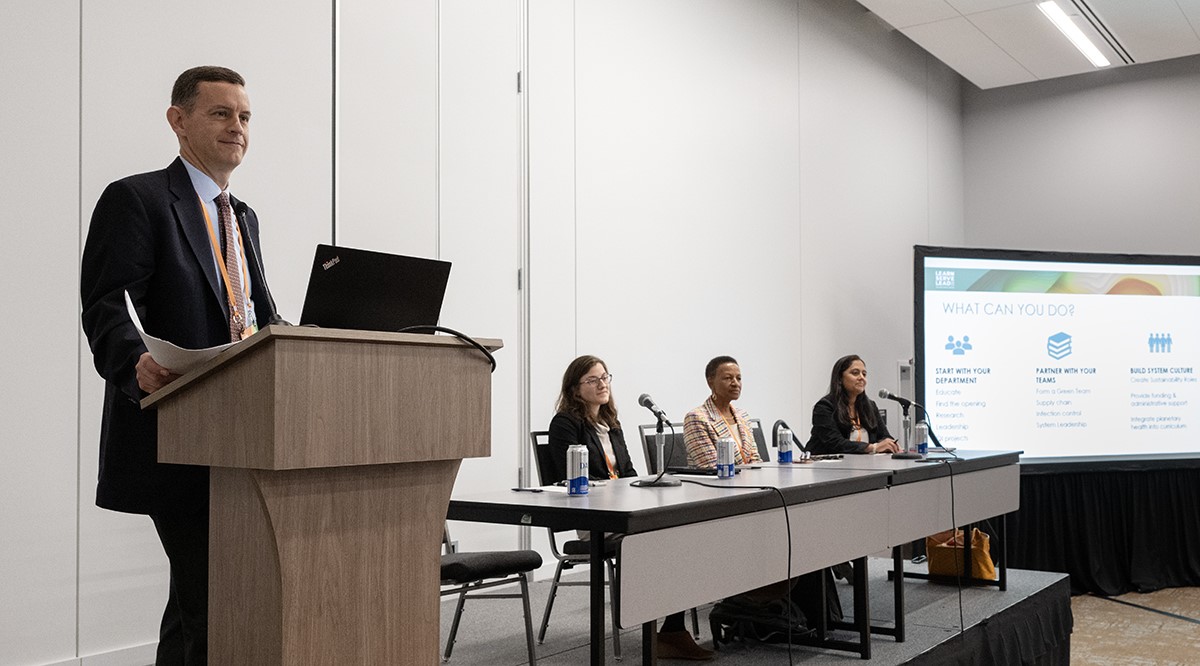
Students at the Indiana University School of Medicine in Indianapolis, on a mission to reduce the amount of waste produced by medical facilities, were shocked to learn how many surgical drapes were being used for just about every patient at a surgical center in a nearby town.
“For every cataract surgery, each patient was draped fully from head to toe despite the fact that the entire surgical space used was from the shoulders up,” Stella Protopapas, a medical student who organized the initiative, told fellow students and medical professionals during a session on Sunday, Nov. 5, at Learn Serve Lead 2023: The AAMC Annual Meeting.
The students convinced the center to reduce its use of drapes when it was medically safe to do so — a small but important step toward reducing the carbon footprint of the health care sector.
Protopapas was one of three panelists to share examples of how medical schools and hospitals can reduce their carbon footprint — from individual actions to institution-wide changes — in a session, “Decarbonizing Academic Medicine Across Mission Areas.”
Academic medical centers need to take on their own role in climate change because “we are part of the problem,” said moderator William Mallon, EdD, senior director of strategy and innovation development at the AAMC.
The U.S. health care sector is responsible for an estimated 8% to 10% of total greenhouse gas emissions, Mallon said. “If the U.S. health sector were a country, it would have more carbon emissions than the United Kingdom.”
Protopapas took on the challenge by organizing an audit of waste produced by medical procedures at an outpatient surgical center in Evansville, Indiana, in 2022. A group of medical students measured materials discarded from 26 procedures conducted in one day, including ophthalmology, plastic surgery, urology, and general surgery.
They gathered 112 kilograms (nearly 250 pounds) of waste, with the biggest sources being textiles (such as towels and surgical drapes), followed by hard plastics (such as equipment parts). On a per-case basis, “plastic surgery was the most waste-intensive,” Protopapas said.
The students made several recommendations to the clinic, which cooperated with the audit, including reducing the use of drapes, reducing the use of single-use blood pressure cuffs, and streamlining supply orders through a central system so that doctors are not all making individual orders, which often brings in more materials collectively than the clinic needs. Although the clinic changed its draping practices, Protopapas says, progress on the other recommendations has been slow.
In Utah, anesthesiologist Smitha Warrier, MD, demonstrated how individuals can effect change in one area across their hospital systems. Warrier, medical director of environmental and social sustainability at University of Utah Health in Salt Lake City, became aware several years ago that many of the most commonly used inhaled anesthetics are particularly potent greenhouse gases. They are released from operating rooms to the outdoors through hospital venting systems.
Warrier began her campaign by changing the anesthesia that she uses, taking advantage of the autonomy that her role provides. “There was no red tape, no hoops to jump through” to get administrative approval, she said.
From there, Warrier worked with colleagues and administrators to broaden the change in anesthetics throughout the health system’s operating rooms. She noted that changing to an anesthesia that is less environmentally damaging is “low-hanging fruit” for hospitals, because the alternatives are readily available and cost less.
On a larger scale, the University of California Riverside has made the reduction of its carbon footprint a priority across its campus and throughout its educational, medical, and research missions.
“We [medical school leaders] are responsible for working toward hard-wiring the importance of decarbonization and sustainability across the mission” for medical education, patient care, and research, said Deborah Deas, MD, MPH, vice chancellor for health sciences at UC Riverside and the Mark and Pam Rubin Dean at the university's school of medicine.
One way UC Riverside has done this is through solar energy: It installed solar panels on existing buildings and includes them on all new buildings, and created a solar panel farm in parking lots, Deas said. In food services, the campus has increased its purchases of plant-based foods. For transportation, it installed more than 150 electrical vehicle charging ports on campus and is making sure that new vehicles use renewable energy.
The school is also working with the local utility company to study how it can further reduce its carbon footprint. “The goal is to find a path forward to a new energy source that is not fossil fuel,” she said.
The panelists offered recommendations for any medical students and professionals wanting to get involved in moving their institutions to reduce their carbon footprints:
- Start in your own department, and engage colleagues to join you. Many of them will enthusiastically look for areas of concern and solutions. “It's very contagious when you start doing this work,” Warrier said.
- Move on to develop teams across departments that can bring their insights to working toward solutions and help to build support for specific measures.
- Communicate with staff about the reason for those measures, to increase buy-in.
- Work with community groups that have expertise in some areas that affect sustainability and can connect the health care system to other partners.
You don’t have to be an environmental expert, Warrier added. “It’s just figuring out how we connect the dots” between how routine medical practices contribute to climate change. “One of the things we can do is just build awareness” among colleagues and administrators.
